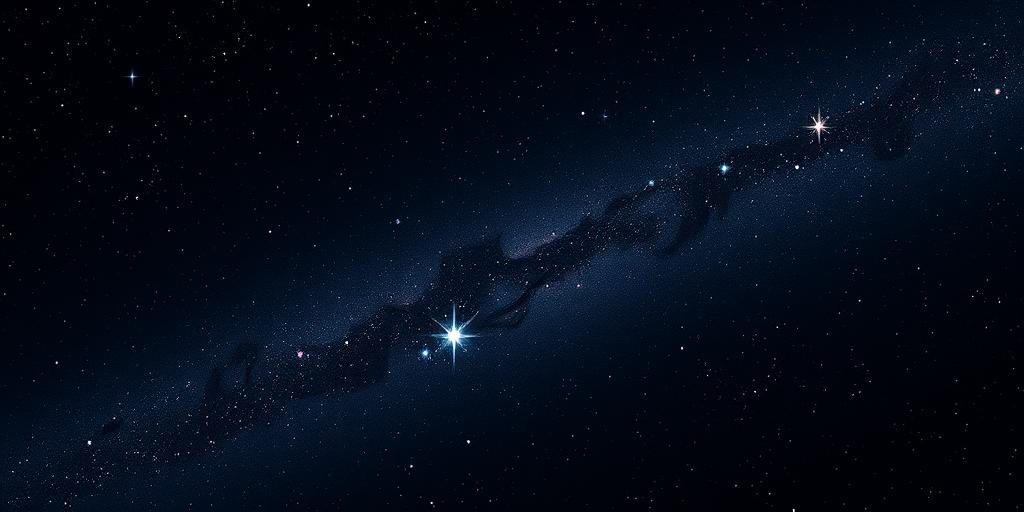Dark Matter: The Invisible Scaffolding of the Universe
The universe is a vast and mysterious place, filled with wonders that both inspire and confound us. Among the greatest enigmas is dark matter, a substance that makes up approximately 85% of the universe's mass but does not interact with light, rendering it invisible to our telescopes. This article delves into the fascinating world of dark matter, exploring its properties, its role in the cosmos, and the ongoing quest to understand its true nature.
What is Dark Matter?
Dark matter is a hypothetical form of matter that does not emit, absorb, or reflect light or any other electromagnetic radiation. Its existence was first inferred from observations of galaxies and galaxy clusters, which exhibited gravitational effects that could not be explained by the visible matter alone. In essence, galaxies were spinning faster than they should, given the amount of ordinary matter they contained, suggesting that something unseen was providing additional gravitational pull.
Evidence for Dark Matter
Several lines of evidence support the existence of dark matter:
- Galactic Rotation Curves: As mentioned earlier, the speeds of stars at the outer edges of galaxies do not decrease with distance from the galactic center as predicted by Newtonian physics. This implies the presence of a dark matter halo surrounding galaxies.
- Gravitational Lensing: The bending of light around massive objects, known as gravitational lensing, is more pronounced than can be accounted for by visible matter alone. Dark matter contributes to this lensing effect, further supporting its existence.
- Cosmic Microwave Background (CMB): The CMB, the afterglow of the Big Bang, contains subtle temperature fluctuations that provide insights into the early universe. These fluctuations indicate that dark matter played a crucial role in the formation of cosmic structures.
- Structure Formation: Simulations of the universe's evolution show that dark matter is essential for the formation of galaxies and large-scale structures. Without it, the universe would be a much more uniform and featureless place.
The Role of Dark Matter in the Universe
Dark matter acts as a kind of scaffolding upon which the visible universe is built. It provides the gravitational framework that allows galaxies to form and cluster together. Without dark matter, the universe would likely consist of a diffuse gas, lacking the intricate structures we observe today.
The Quest to Detect Dark Matter
Despite the compelling evidence for its existence, dark matter remains elusive. Scientists are actively engaged in experiments to directly detect dark matter particles. These experiments fall into several categories:
- Direct Detection: These experiments aim to detect dark matter particles as they pass through the Earth. Highly sensitive detectors are used to look for the faint interactions between dark matter particles and ordinary matter.
- Indirect Detection: This approach searches for the products of dark matter annihilation or decay, such as gamma rays, cosmic rays, and neutrinos. These signals could provide clues about the nature of dark matter particles.
- Collider Experiments: Particle colliders, such as the Large Hadron Collider (LHC) at CERN, are used to create conditions similar to those in the early universe, with the hope of producing dark matter particles in the laboratory.
Potential Candidates for Dark Matter
Numerous theoretical candidates have been proposed to explain dark matter. Some of the leading candidates include:
- Weakly Interacting Massive Particles (WIMPs): WIMPs are hypothetical particles that interact with ordinary matter through the weak nuclear force and gravity. They are among the most studied dark matter candidates.
- Axions: Axions are lightweight particles that were originally proposed to solve a problem in particle physics. They are also considered a promising dark matter candidate.
- Sterile Neutrinos: Sterile neutrinos are hypothetical particles that do not interact with ordinary matter through the weak force, making them difficult to detect.
- Primordial Black Holes: These are black holes that may have formed in the very early universe. While controversial, they remain a potential candidate for a fraction of dark matter.
Conclusion
Dark matter remains one of the most profound mysteries in modern cosmology. Its existence is supported by a wealth of evidence, yet its true nature remains elusive. The ongoing quest to understand dark matter is driving innovation in experimental physics and theoretical cosmology, promising to unlock new insights into the fundamental nature of the universe. As we continue to explore the cosmos, the invisible scaffolding of dark matter will undoubtedly play a central role in shaping our understanding of the universe's past, present, and future.









